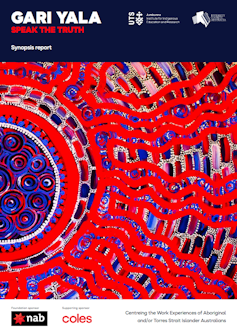10 ways employers can include Indigenous Australians
- Written by Nareen Young, Industry Professor, Jumbunna Institute of Education and Research, University of Technology Sydney
The results of the first large-scale survey of the experience of Aboriginal and Torres Strait Islander people at work give plenty of food for thought.
They show that racism and prejudice remain important issues, but there is much more at play – concerned with the “cultural weight” many people feel from being an Indigenous person in a largely non-Indigenous organisation.
The report, called Gari Yala – meaning “speak the truth” in Wiradjuri, the language once spoken over most of what now is inland New South Wales – is based on surveying 1,033 Aboriginal and/or Torres Strait Islander people.
The survey was carried out by the Jumbunna Institute for Indigenous Research and Education at the University of Technology Sydney and Diversity Council Australia, a not-for-profit organisation that promotes diversity and inclusion in the workplace. It has more than 600 corporate members. (Two of those, National Australia Bank and Coles, funded this project.)
Responses were collected from the council’s member organisations, research panels, community groups and through social media. The results are reflective of, rather than representative of, the views of all Aboriginal and/or Torres Strait Islander people.
Our main findings
About four in every five respondents (78%) said they felt sharing their Aboriginal and/or Torres Strait Islander background at work was important.
 The ‘Gari Yala’ report.
UTS/Diversity Council Australia
The ‘Gari Yala’ report.
UTS/Diversity Council Australia
More than a quarter said they didn’t feel their perspectives and experiences were valued, and they didn’t feel comfortable talking about their culture.
Almost two-thirds said they experienced what we have termed high “identity strain” (this is explained below).
Well over a third (39%) said they felt what we call a “high cultural load” (this term is also explained below).
A similar proportion (38%) said they felt they had been treated unfairly because of their Indigenous background, with 59% having heard comments about how they looked or “should look” as an Aboriginal or Torres Strait Islander person, and 44% subject to racial slurs.
Read more: It's time we moved the goalposts on Indigenous policies, so they reflect Indigenous values
What is identity strain?
The research team coined the term identity strain. It refers to “the strain employees feel when they themselves, or others, view their identity as not meeting the norms or expectations of the dominant culture in the workplace”.
One participant put it this way:
Each time I share different parts of me to the same people or reshare to new people, it always changes the relationship and I am then required to adjust how and why we interact to help them feel comfortable. Keeping mental notes and constantly assessing how safe the space is depending on who is the room.“
Almost two-thirds of respondents described high levels of identity strain:
65% said they felt they had to work harder to prove they, as an Indigenous person, could do the job
33% said they had been told to "tone it down” or be less outspoken about Indigenous issues.
What is cultural load?
Cultural load is the extra burden carried by Aboriginal and/or Torres Strait Islander people in workplaces where there are few or no other Indigenous people.
Almost 40% felt they carried a high cultural load in their workplace, which plays out through:
extra work demands: 66% said they had extra Indigenous-related work demands placed on them that non-Indigenous colleagues don’t, such as organising NAIDOC Week events, doing acknowledgements of Country or seeing all Indigenous clients on top of their other work
expectation to educate others: 71% said they were expected by others at work to educate non-Indigenous colleagues about racism and Indigenous issues
expectation to represent all Indigenous people: 69% said they felt expected to talk on behalf of all Aboriginal and/or Torres Strait Islander people.
Read more: Why we aren't closing the gap: a failure to account for 'cultural counterfactuals'
What can employers do?
Organisations may say they want to create a workplace that treats Indigenous people and employees equitably.
But only a quarter of our survey participants said they worked in organisations they felt were authentically committed to change – acting, rather than simply saying they were committed to act.
Participants working in organisations they felt were authentic were more satisfied than others, and were less likely to leave.
We’ve identified 10 key points for organisations to improve workplace inclusion.
Ask Aboriginal and/or Torres Strait Islander staff about how it is to work there. Listen to what you are told with an open heart, however uncomfortable this may be
ensure any Aboriginal and/or Torres Strait Islander-related work is led and informed by Indigenous people. This means engaging with Indigenous people both inside and outside your organisation
develop specific principles for your own organisation that guide how Indigenous community engagement and employment should work in practice
don’t focus on getting Indigenous people “work-ready”. Focus on your organisation’s readiness to employ Indigenous people
recognise identity strain and educate non-Indigenous staff about how to interact with their Indigenous colleagues in ways that reduce this
recognise that cultural load exists, is real and is a burden. Recognise it in job descriptions and compensate it
consult with Indigenous staff on how to minimise cultural load while increasing cultural safety. This will take honest discussion and probably the commitment of resources
build better careers for Aboriginal and/or Torres Strait Islander people by supporting career development and leadership development
act on workplace racism. Make complaint mechanisms clear, train managers and never brush it under the carpet. Our results suggest formal racism complaint procedures are uncommon
look to high-impact initiatives that evidence-based research shows increase Indigenous employees’ well-being and retention. These include formal career development programs, mentoring and support, anti-discrimination training and celebrating Aboriginal and Torres Strait Islander days and weeks of significance.
The full and summary reports are available from Diversity Council Australia’s website.
Authors: Nareen Young, Industry Professor, Jumbunna Institute of Education and Research, University of Technology Sydney
Read more https://theconversation.com/10-ways-employers-can-include-indigenous-australians-149741



















